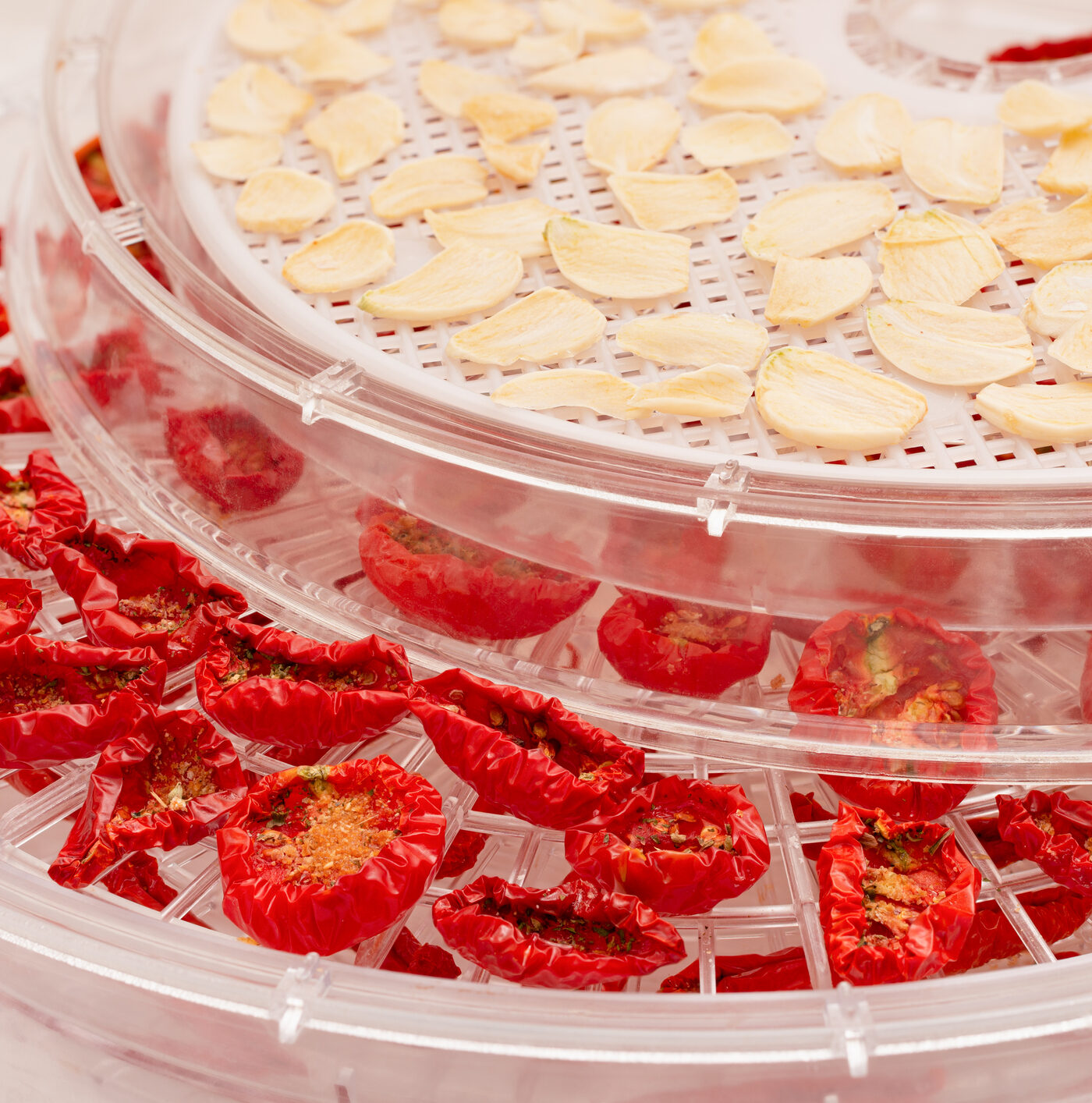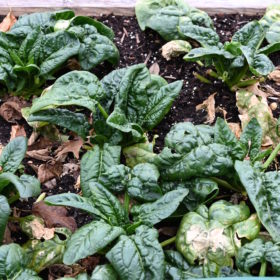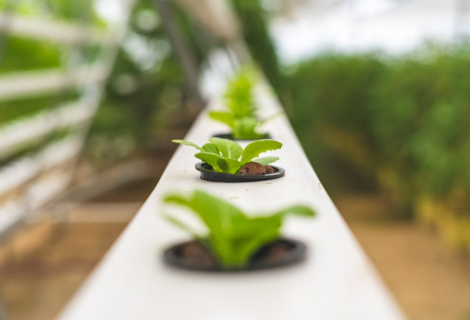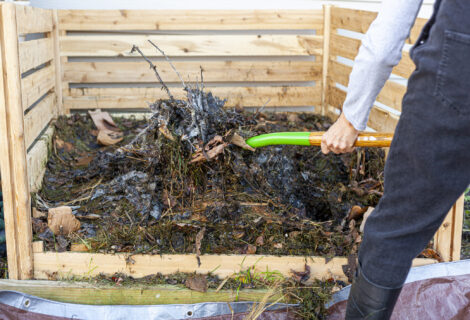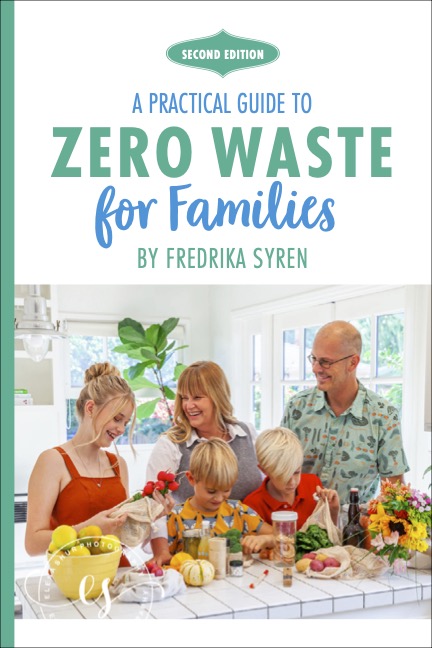Dehydrate Your Harvest!
It’s the time of year when everything seems to ripen at once! We have ripe plums, blueberries, apples, and pears right now, and it’s a challenge to harvest and keep these fruits while they last! While some fruits and vegetables are canned or made into jam, we also spend time drying much of our harvest.
The benefit of drying compared to canning or freezing is that it’s simpler. No extensive preparation is needed, and dried food requires very little space to preserve. As for storing it, compared to frozen or canned food, dried food stored properly in closed bags or jars with lids will last for a very long time.
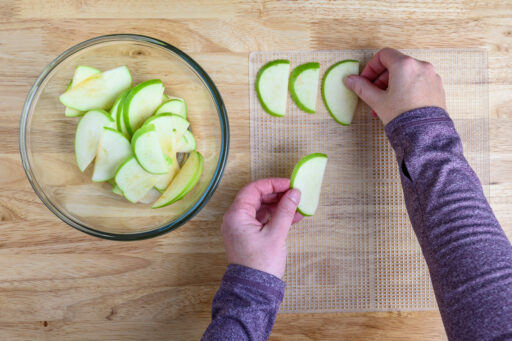
Even if you don’t grow your own food, you can still preserve summer goodies. And fall is the perfect time to do it! When we lived without a garden, we made a point in the fall to preserve farmer’s market bounties so we could eat healthy, local food throughout the winter.
Drying doesn’t require a lot of energy, and it concentrates flavors, magically turning fresh fruits into something like candies. There are different ways to dry vegetables, beans, mushrooms, fruits, and berries, but here are the main ones:
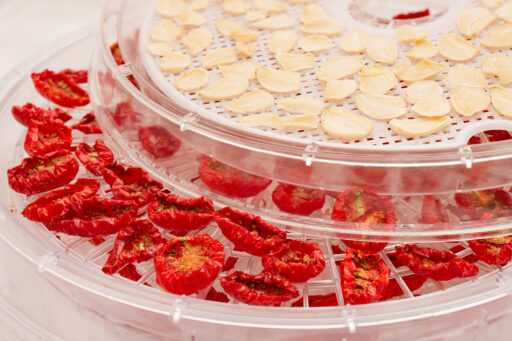
- Sun-drying uses the smallest carbon footprint; no gas or electricity is needed. Cons: Requires three to five consecutive days of 95-degree temperatures and low humidity.
- Oven drying requires no special equipment. Simply place sliced fruit or veggies on a baking sheet and set your oven’s temperature to its lowest setting. Cons: It uses gas or electricity and restricts the use of the oven for six to twelve hours.
- Dehydrators free up the oven and can dehydrate several square feet of food at once in stacked layers. They have a relatively small footprint on the countertop. Cons: They’re expensive, plastic, and use electricity. For tips on choosing a food dehydrator, click here.
The possibilities for transforming food through dehydration are endless.
Here are a few ideas:
Kale Chips— If you have a kale hater in your home, give them these chips to try. They’re crispy, crunchy, salty, and highly addictive. To make them, simply remove the stems and spines, wash and spin-dry the leaves, spread them on a baking sheet, drizzle with olive oil and salt, and bake on low until they’re crisped. Take it a step further with this recipe for Sundried Tomato and Cheezy Kale Chips.
Sun-Dried Tomatoes— You can use any drying method to dry tomatoes. Choose meatier tomatoes like Roma or Beefsteak. Remove cores, then slice in half lengthwise. Cut into 1-inch-thick wedges. Arrange wedges skin side down, with plenty of room between for air to circulate. Dehydrate at 135 to 145 degrees for six to twelve hours, depending on the tomatoes’ juiciness. Store in an air-tight container. Rehydrate in hot water, crush and add to soups or stews, or blitz in a processor for tomato powder. Sun-dried tomatoes also can be stored in oil.
Berries— Four cups of fresh fruit reduces to about one cup of puree. For strawberries, hull the cores and slice berries lengthwise into thirds. For blueberries, blanch in boiling water for about 30 seconds to tenderize the tough skins, then pat dry and dehydrate whole. For raspberries or blackberries, wash and dry berries thoroughly, then arrange in a single layer, spray lightly with lemon juice to keep them from turning brown, and dehydrate at 135 degrees for fifteen to eighteen hours.
Mushrooms— Drying mushrooms concentrates their flavor, adding savory umami to any dish. Dried mushrooms can be stored for years; just soak in boiling water to reconstitute them. First, clean mushrooms with a soft brush or damp paper towel. Slice them about ⅛ inch thick and arrange on a baking sheet in a single layer. Then, cook at 150 degrees for one hour. Remove mushrooms and turn them over. Blot any moisture that has sweated out of the mushrooms with paper towels. Cook for another hour. At this point, the mushrooms should be dried entirely; if not, repeat blotting and baking. Allow to cool, and store in an air-tight container in a cool, dark place. Also, see these tips on foraging for mushrooms or growing your own at home.
Herbs and Edible Flowers— Got mint or rosemary taking over your garden? Drying herbs is a great way to save them for year-round use. Garnishing salads or desserts with edible flowers adds delightful pops of color. For tips on which flowers are safe to eat and ways to use dried herbs and flowers, click here.
Rose Hips— Speaking of flowers, rose hips are the small, cherry-sized fruit left behind after roses have faded. Rose hips have a spicy, nutty, sweet-tart floral flavor and are full of vitamin C. They can be dried for tea or eaten as a snack, like dried berries. After the roses have died, collect the hips and wash them gently. Cut hips in half and scrape out the hairy seeds. Dry on a baking sheet, checking frequently and stirring often so they don’t burn. You can also string them on a thread with a needle (leave room between each hip) and hang them in a cool, dry place for a few days. Store in an airtight container. For tea, steep the hips in boiling water or add them to tisane blends with other herbs like chamomile, hibiscus blossoms, rose petals, elderberries, calendula, or citrus zest.
Citrus Zest— Speaking of citrus zest, you can save the rinds of lemons, limes, oranges, and grapefruits after squeezing their juice and make dehydrated zest. You can make things like citrus powder, citrus extract, citrus sugar, citrus-infused oil, and lemon pepper with dehydrated zest. Use a zester to scrape just the outer layer of the skin, leaving behind the bitter white pith. Spread zest on parchment paper and dry in a warm, low-moisture area. Store in an airtight container. Check out these 20 Uses for Leftover Rinds and Peels for more ideas.
Banana Chips— Have a bunch of bananas about to turn brown? You could make banana bread or freeze them for smoothies, but you also could make banana chips (another kid favorite)! To make them, peel and slice bananas, then spritz with lemon juice to prevent browning. Arrange on a lightly oiled baking sheet in a single layer. Dry in the oven at 175 degrees for two to three hours until crisped and golden. Cool completely and store in airtight containers.
Fruit leather— Kids adore fruit leather, and it can be stored for 30 days at room temperature, for months in the refrigerator, or years in the freezer. Any type of ripe fruit can be used. Remove pits, stones, and seeds. You can remove the peel if you desire. Add one tablespoon of lemon juice per quart of any fruit that might turn brown. Add sugar to taste (optional), and cook over medium heat until tender. Puree in a blender until smooth. Cover a cookie sheet with parchment paper, then pour puree onto the parchment into a ¼-inch thick layer, spreading evenly. Place in the oven on the lowest setting with the oven door cracked open for four to six hours or until the fruit leather is no longer sticky. You can also make fruit leather from rose hips!
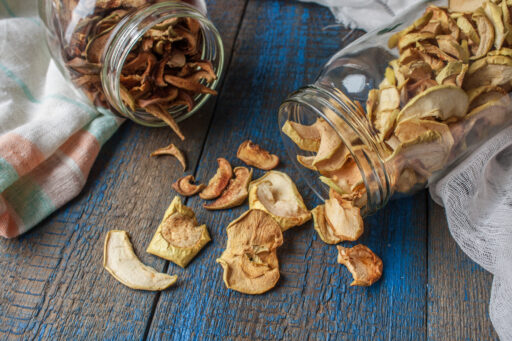
Here are some tips for successful drying of food:
- Spread your foods in a single layer on the trays, allowing room for circulation.
- Move the food around at least once daily—more often speeds the process up.
- The food is dry enough when it becomes leathery or brittle.
- To prevent discoloring of certain fruits like apples, you can dip them into lemon water before drying.
Use your imagination to explore all the possibilities food-drying provides. Our family loves drying herbs, tea, snacks like plums, pears, and apples, and making raisins from grapes. Dried vegetables are easy to store and perfect for adding to soups and stews, cooking in a crock pot, or snacking. Kale and beet leaf chips never get old!


